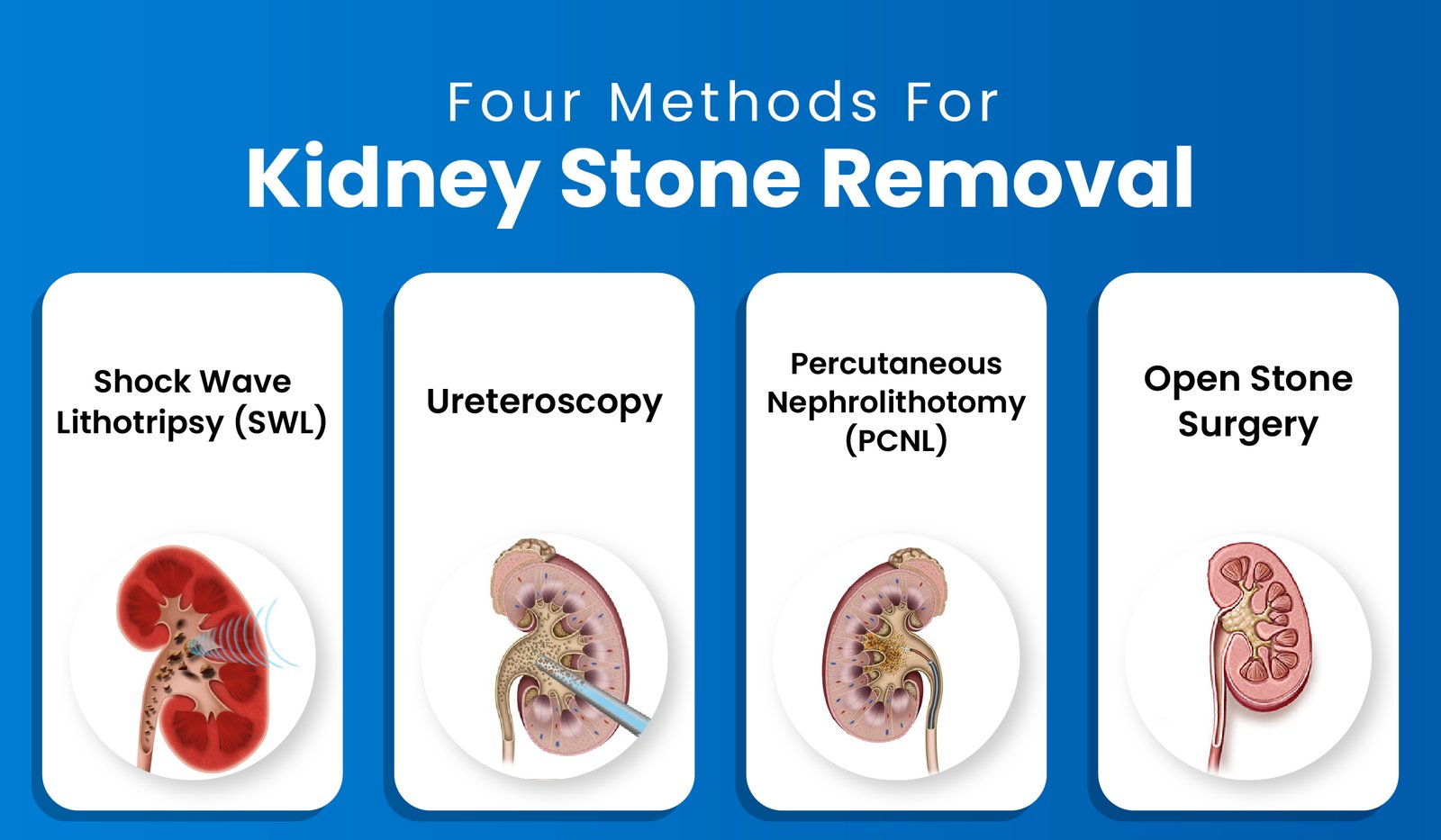Kidney stones, those pesky, painful mineral deposits in your kidneys, can be a source of significant discomfort and concern. Whether you’re googling “Kidney Stone Doctor Near Me” or pondering over the need for surgery, this blog aims to provide comprehensive answers and insights into the world of kidney stone treatment.
Table of Contents
What Size of Kidney Stone Requires Surgery?
The decision to opt for surgery often depends on the size of the kidney stone. Generally, stones smaller than 4 millimeters (mm) can pass on their own, while those between 4 and 6 mm have a fair chance of passing without surgical intervention. Stones larger than 6 mm, however, are likely to require some form of surgical removal, as they are less likely to pass naturally and more likely to cause pain, blockages, or infections.
Four Methods for Kidney Stone Removal
- Shock Wave Lithotripsy (SWL): This non-invasive procedure uses shock waves to break stones into tiny pieces, making them easier to pass. It’s effective for stones less than 2 centimeters in size.
- Ureteroscopy: A minimally invasive procedure where a scope is inserted into the urethra and bladder to reach the stone. If the stone is large, it’s broken up using a laser.
- Percutaneous Nephrolithotomy (PCNL): Recommended for larger stones (over 2 centimeters), this involves making a small incision in the back to remove the stone directly.
- Open Surgery: The most invasive option used rarely and typically when other methods aren’t suitable. It involves a larger incision to remove the stone.

Kidney Stone Removal Without Surgery
Many stones can be managed and passed naturally. This non-surgical approach includes drinking plenty of fluids, pain management, and in some cases, medication to help the stone pass.
Duration of Kidney Stone Surgery
- SWL: Typically takes about 45-60 minutes.
- Ureteroscopy: Can last between 1-3 hours depending on the stone’s size and location.
- PCNL: Generally, takes about 2-4 hours.
- Open Surgery: Duration can vary greatly but is generally the longest of all procedures.
Kidney Stone Surgery Recovery Time
Recovery times vary based on the type of surgery:
- SWL: Most patients return to normal activities within a few days.
- Ureteroscopy: Recovery typically takes about 1-2 weeks.
- PCNL: Recovery can take 2-4 weeks.
- Open Surgery: The most extended recovery period, often several weeks to months.
Recovery Time for Stone Removal with Stent
If a stent is placed during surgery, this may extend recovery time. Stents are often used to facilitate the passage of stone fragments and improve healing. The presence of a stent can cause some discomfort and may slightly prolong the recovery process.
Common Procedures for Stone Removal
Kidney stone removal procedures have evolved significantly, offering various options depending on the size, location, and nature of the stones. Among these, Shock Wave Lithotripsy (SWL) and Ureteroscopy are the most common. Let’s delve deeper into these and other methods available:
Shock Wave Lithotripsy (SWL)
- Procedure: SWL is a non-invasive treatment that uses high-energy sound waves to break stones into small pieces, which can then be passed naturally through the urinary tract.
- Ideal For: Small to medium-sized stones (typically less than 2 centimeters).
- Recovery: Often has a quick recovery time. Patients usually resume normal activities within a few days.
- Effectiveness & Considerations: It’s effective for stones located in the kidney or upper ureter. The success rate varies, and sometimes multiple sessions are needed. Patients might experience mild discomfort or bruising.
Ureteroscopy
- Procedure: A thin, flexible instrument called a ureteroscope is inserted through the urethra and bladder into the ureter or kidney. Stones are either removed using a basket device or broken into smaller pieces with a laser.
- Ideal For: Stones of various sizes, particularly effective for stones lodged in the ureters or for stones that have not responded to SWL.
- Recovery: Recovery time is typically about 1-2 weeks. Stents are often placed temporarily to aid healing.
- Effectiveness & Considerations: It has a high success rate for stones in the lower urinary tract. The procedure is minimally invasive but may cause discomfort or urinary symptoms.
Additional Procedures:
In addition to SWL and Ureteroscopy, there are other notable procedures:
Percutaneous Nephrolithotomy (PCNL)
- Procedure: This involves a small incision in the patient’s back to create a direct channel to the kidney. Through this, a surgeon can remove larger stones or break them into smaller pieces.
- Ideal For: Large stones (over 2 centimeters), especially in the kidney.
- Recovery: It requires a longer recovery time, typically 2-4 weeks, with possible hospitalization.
- Effectiveness & Considerations: PCNL is highly effective for large stones and offers a good alternative when other methods are not suitable. It carries risks typical of more invasive surgeries, like bleeding or infection.
Open Surgery
- Procedure: Involves a significant incision to access the kidney or ureter to remove the stone directly.
- Ideal For: Very large or complex stones, or when other procedures are not feasible.
- Recovery: Recovery is the longest among all procedures, often requiring several weeks to months.
- Effectiveness & Considerations: Though rarely used due to the effectiveness of less invasive methods, it’s still an option when necessary. The risks are higher due to the invasiveness of the procedure.
Conclusion
To sum up, managing kidney stones effectively requires understanding the various surgical options and recovery processes. Consulting Urology doctors like Dr. Dushyant Pawar can provide invaluable insights, especially when considering procedures like kidney stone surgery. Remember, personalized advice from a specialized Kidney Stone Doctor is crucial for making informed decisions about your health. With the right guidance and information, navigating the path to recovery can be a smoother process.
FAQs
Q: When is surgery necessary for kidney stones?
A: Surgery may be required if stones are too large to pass, causing persistent pain, blocking urine flow, or leading to complications.
Q: What causes kidney stones?
A: Kidney stones can form due to dehydration, dietary factors, family history, or certain medical conditions.
Q: How do I know if I have a kidney stone?
A: Common symptoms include severe pain in the back or side, blood in urine, and frequent urination. Consult a doctor for a diagnosis.
Q: Can kidney stones pass on their own?
A: Small stones may pass naturally, but larger ones may require medical intervention or surgical procedures for removal.
Q: What are the non-surgical treatments for kidney stones?
A: Options include increased fluid intake, medications, and shock wave lithotripsy to break down stones into smaller fragments for easier passage.



